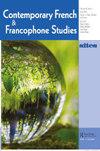Photographie et réserve d’imaginaire
IF 0.2
4区 文学
0 LITERATURE, ROMANCE
引用次数: 0
Abstract
Abstract The first hermaphrodite photographs date from 1860 by Nadar. They are mostly framed by an anatomical and medical perspective according to which hermaphroditism is a pathology. However, one can read something much more ambiguous in this series. Other relationships are played at the margins of categories of gender, sex, sexuality, reality and fiction. I propose to re-read these photos according to the perspective of what I call a “reserve of imagination.” Reserve of imagination consists of dream visions from which new universes emerge. It also emphasizes the potential for heterotopic places to remain marginalized. This other interpretation of Nadar was developed in the photographic sense of the term; it developed afterwards through the work of SMITH, French contemporary artist working among other things on gender. The very idea of indeterminacy, which constitutes SMITH's queer thinking and aesthetics, was already present in Nadar's notable use of blurring and framing. SMITH's photographs of intersex people radically overturn the anatomical and medical gaze: intersex is no longer a pathology. If, the medical thought of the 19th and early 20th century would have liked to visually include hermaphrodites in the category of the degeneration, it did not succeed, thanks to this reserve of imagination.摄影和想象储备
第一张两性照片是纳达尔于1860年拍摄的。它们大多是从解剖学和医学的角度来构建的,根据这个角度,两性畸形是一种病理学。然而,在这个系列中,人们可以读到一些更模糊的东西。其他关系是在性别、性、性、现实和小说类别的边缘发挥作用的。我建议根据我所说的“想象力储备”的视角重读这些照片。想象力储备由新宇宙出现的梦境组成。它还强调了异位场所仍然被边缘化的可能性。对纳达尔的另一种解释是在这个术语的摄影意义上发展起来的;它后来通过法国当代艺术家史密斯的作品发展起来,史密斯致力于性别研究。正是不确定性的概念,构成了史密斯的酷儿思维和美学,已经出现在纳达尔对模糊和框架的显著使用中。史密斯拍摄的双性人照片从根本上颠覆了解剖学和医学界的观点:双性人不再是一种病理学。如果19世纪和20世纪初的医学思想希望在视觉上将雌雄同体纳入退化的范畴,那么由于这种想象力的储备,它并没有成功。
本文章由计算机程序翻译,如有差异,请以英文原文为准。
求助全文
约1分钟内获得全文
求助全文
来源期刊

Contemporary French and Francophone Studies
LITERATURE, ROMANCE-
CiteScore
0.30
自引率
0.00%
发文量
43
期刊介绍:
An established journal of reference inviting all critical approaches on the latest debates and issues in the field, Contemporary French & Francophone Studies (formerly known as SITES) provides a forum not only for academics, but for novelists, poets, artists, journalists, and filmmakers as well. In addition to its focus on French and Francophone studies, one of the journal"s primary objectives is to reflect the interdisciplinary direction taken by the field and by the humanities and the arts in general. CF&FS is published five times per year, with four issues devoted to particular themes, and a fifth issue, “The Open Issue” welcoming non-thematic contributions.
 求助内容:
求助内容: 应助结果提醒方式:
应助结果提醒方式:


